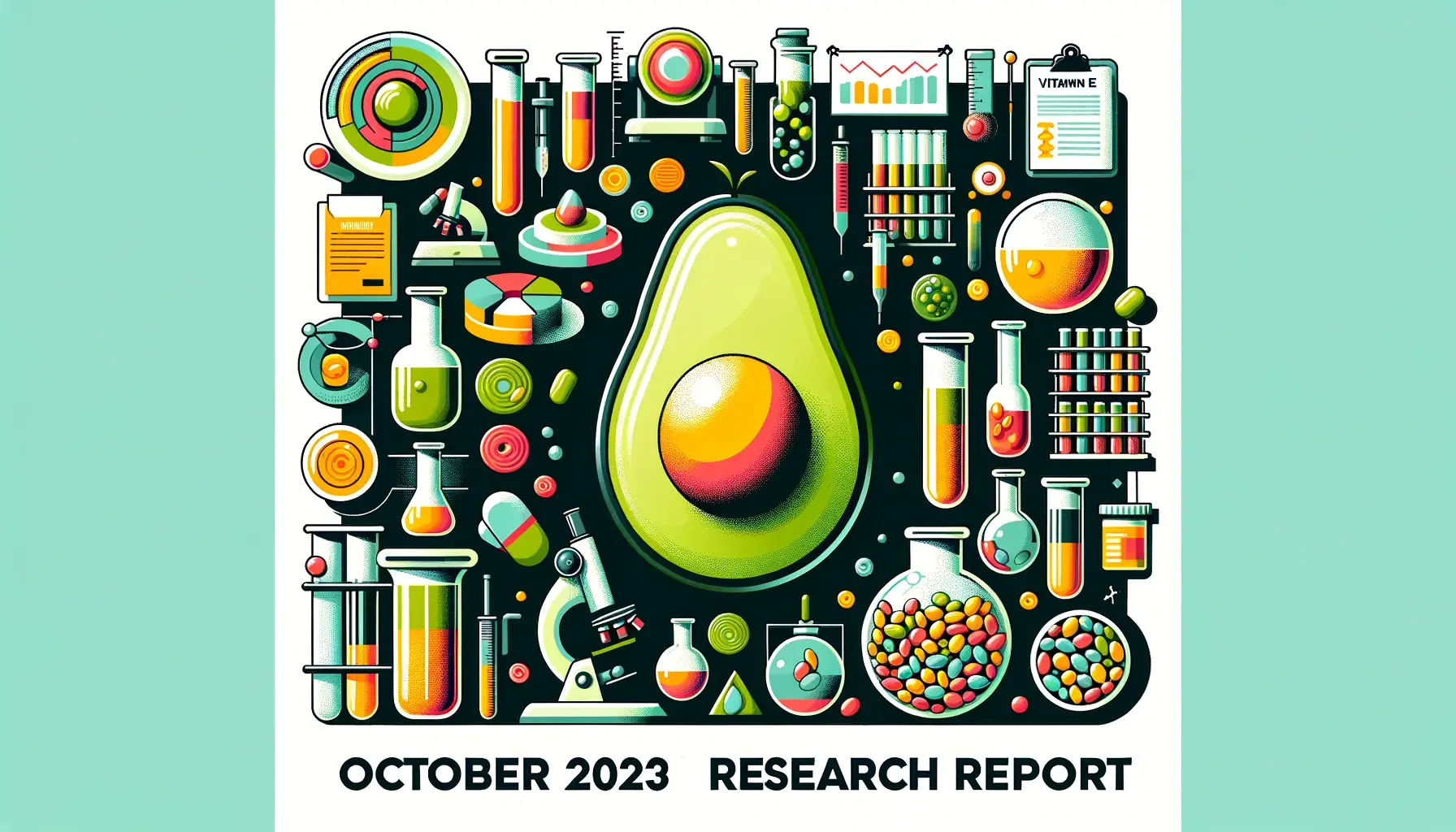Vitamin E Research: Top 5 Discoveries in October 2023

Vitamin E is a crucial nutrient for the human body that notably serves as a potent antioxidant. It aids in immune function, prevents clots in the heart, repairs damaged skin, and thickens hair, among other roles. Recent cutting-edge studies have uncovered more valuable insights about its function and potential therapeutic qualities. Here are five exciting research areas on Vitamin E that are igniting scientific curiosity and public interest.
1. Treating Eye and Muscle Conditions
Optic atrophy and Myopathy related to FDX2 dysfunction could be managed through Vitamin E supplements. The findings signify the potential of vitamin E in offering non-invasive supportive therapies.
Vitamin E can potentially manage optic atrophy and myopathy related to FDX2 dysfunction [1]
In a fascinating research conducted by Foley et al, a young patient exhibiting features of optic atrophy and myopathy, symptoms associated with defective FDX2 function was closely studied. In this exceptional case, the patient was blind by 17 months old. Upon investigation, the patient was found to possess unique FDX2 variations which resulted in dysfunctional interactions with the mitochondrial oxidative phosphorylation system—a key element for producing cellular energy. A treatment plan involving Idebenone, a Co-enzyme Q10 analog, was introduced when the patient was 3 years old. Despite some limitations with the dosage due to neutropenia, the introduction of Idebenone led to some improvement in the patient's condition. To further boost the mitochondrial function, mitoquinol mesylate (MitoQ), another type of Co-enzyme Q10 analog, was incorporated into the treatment plan. This resulted in a significant increase in ATP-linked and maximal respiration, basal oxygen consumption rate, and spare respiratory capacity. After two years of consistent use of MitoQ, the patient's stamina improved, with stable-to-improved walking ability observed. Yet, despite some reduced roving eye movements, the patient's condition maintained as fully blind. The study was broadened by adding L-carnitine, biotin, alpha-lipoic acid, riboflavin, and vitamin E to the MitoQ treatment. While no immediate results were reported, the use of Vitamin E and other supplements represent a promising, non-invasive supplement to traditional medical treatments. The effect of these supplements on the FDX2 dysfunction is currently being tested.
2. Anticancer Properties
Vitamin E succinate has been found to potentially trigger apoptosis in cancer cells. This research can widen the scope of preventive and therapeutic options in the fight against cancer.
Vitamin E Succinate Triggers Apoptosis in Cancer Cells [2]
Recent studies have shown fascinating results in the field of cancer research revolving around Vitamin E succinate (VES), an esterified form of natural α-tocopherol, bringing it to light as a potential anticancer agent. The mechanisms through which VES could battle cancer cells were previously not clearly defined, but new findings suggest an intricate process that underlies its efficacy. VES seems to mediate the cellular mechanism of apoptosis in cancer cells by essentially overloading them with calcium.
The more microscopic details of this process are as fascinating. The data suggest that Vitamin E succinate induces a release of calcium (Ca2+) from a part of the cell known as the endoplasmic reticulum (ER), leading subsequently to an overload of calcium in another part of the cell known as the mitochondria. This in turn leads to a loss of function (depolarization) of the mitochondria, and finally results in the death of the cell through a process known as apoptosis. In other words, Vitamin E pulls a masterstroke in the fight against cancer by inducing self-harm within the cancer cells until they can't cope anymore.
Further light was shed on the intricacies of the mechanism through the visualization provided by transmission electron microscopic observations, which confirmed that Vitamin E succinate does indeed trigger contact between the ER and the mitochondria. Further, pre-treatment with certain compounds even decreased this contact, suggesting the influence of this vitamin in bringing about this cellular action.
The research also involved another key player involved in this fighting mechanism – a protein named glucose-regulated protein 75 kDa (GRP75). Although the level of this protein remained unaffected after the administration of Vitamin E succinate, the location of GRP75 within the cell was observed to shift towards an area where the ER is in association with the mitochondria.
In summary, the study indicates a complex series of reactions possibly fueled by Vitamin E succinate, leading to overrun cancer cells with calcium, which then speeds up the death process for these cells. This research adds significantly to the growing body of evidence that suggests Vitamin E succinate as a potential anticancer agent and provides hope for new strategies in cancer prevention and treatment.
3. Preventing Nerve Damage
Excess exposure to Manganese can lead to neurotoxicity, and Vitamin E's power as an ROS scavenger may provide defense. This points to a potential role of Vitamin E in safeguarding against nerve damages.
Vitamin E Shields Against Manganese-Triggered Neurotoxicity [3]
A fascinating new study has examined the protective power of Vitamin E in fighting neurological damage triggered by an overload of Manganese (Mn). High exposure to Mn can induce neurotoxicity and even lead to a condition called manganism, which can affect motor control and cognitive functions similar to Parkinson's disease. Vitamin E, a proven defender in the realm of neurological health, works by acting as a scavenger for Reactive Oxygen Species (ROS) that can wreak havoc in our nervous system, thereby preventing mitochondrial dysfunction and neuronal apoptosis, or cell death.
In this study, Vitamin E was scrutinized for its effects on Mn-induced lesions in the nigrostriatal system of the brain, a region responsible for movement and often impacted in conditions like Parkinson's. Using male mice for the study, researchers divided them into four groups to analyze the impact of Vitamin E supplement and Mn exposure separately and in combination. Post-injection, a behavior test was performed on the mice, and various neurobiological markers were observed and measured in their brains.
The findings were highly encouraging. Vitamin E not only improved behavioral disorders triggered by Mn exposure, but it also lessened the decrease of critical dopaminergic neurons. It was observed that Vitamin E neutralized Mn-toxicity by restoring the function of mitochondria, the powerhouses of the cell. Also, it was found that Vitamin E’s protective effects were linked to an upsurge in CHRM1 and KCNJ4 mRNA, two crucial players in neurotransmission in the Substantia nigra, a region in the brain.
In conclusion, this study fortifies the role of Vitamin E as a neuroprotective player against Mn-induced neurodegeneration in the nigrostriatal system. These findings underline its potential as a valuable nutrient in combating the destructive effects of Manganese overexposure on the nervous system.
4. Fertility Improvements
Hyperthermia is known to affect male fertility, and vitamin E, combined with other compounds, has shown promising effect in improving semen parameters. This unravels Vitamin E's potential in combatting fertility issues.
Vitamin E and Other Antioxidants Improve Fertility Amidst Scrotal Hyperthermia [4]
Vitamin E, renowned for its potent antioxidant properties, has fascinated researchers for its potential solutions to male infertility issues. A noteworthy study cast light on how the fusion of certain vitamins and compounds can mend semen parameters distorted by hyperthermia, a condition often caused by brief exposure to high temperatures. The research explored the protective effect of curcumin, vitamins D and E, alongside Iron (III) oxide nanoparticles (Fe2O3-NPs), and manganese oxide nanoparticles (MnO2-NPs) on semen qualities. The procedure involved exposing the lower part of a rat to 43 °C on alternate days for five weeks. After the said period, the rats were euthanized, and tissue samples were collected for analyzing sperm parameters and studying the expression of various genes.
The team found that infusing the rat's diet with the combined curcumin, vitamin D, and E, along with Fe2O3-NPs and MnO2-NPs, improved the semen quality considerably. Moreover, it was observed that the toxic effects of Fe2O3 nanoparticles were significantly reduced by curcumin. This impressive blend significantly reduced apoptosis in germ cells—cell death that can negatively impact fertility. The researchers attribute this decrease in apoptosis to the subtle balance between the reduced Bcl-2 gene expression and the amplified expression of Bax, miRNA-21, and circRNA0001518. The exciting findings suggest the potential role of Fe2O3-NPs and Mno2-NPs, especially when fused with antioxidants or vitamins, in improving fertility disrupted by scrotal hyperthermia. The blend of these compounds yielded even better results in terms of improved fertility and reduced toxicity.
5. Skin Protection
Incorporating Vitamin E into nanoemulsions shows potential in protecting the skin from UV degradation and oxidative stress. This exemplifies the value of Vitamin E in skincare and age prevention.
Vitamin E Nanoemulsions Deliver Potent Antioxidants to the Skin [5]
Promising research harks to the benefits of using natural compounds in skincare. A vital element in this exploration is Vitamin E, frequently praised for its antioxidant properties. When incorporated into nano-sized droplets found in emulsions, it significantly amps up the benefits.
These nanoemulsions are exciting as they potentially increase the active ingredient spread in specific skin layers, improving their effectiveness. In this case, alpha-tocopherol, a form of Vitamin E (VE), was observed in oil-in-water nanoemulsions, alongside two emulsifier alternatives.
But what does this mean for your skin?
Beyond their high stability and pleasant aesthetic qualities, these nanoemulsions can go beyond skin's surface, delivering protective VE into deeper layers. They offer a shield from UV degradation, significantly boosting antioxidant activity. As a result, skin receives an effective dose of Vitamin E, reinforcing its defenses against harmful environmental stressors, a notable contributor to ageing.
So, if you're on the hunt for effective, research-backed skincare ingredients, Vitamin E nanoemulsions are worth exploring. By leveraging natural compounds and the latest in skincare technology, your skincare routine could enjoy a potent new ally in the fight against ageing and oxidative stress. As always, technology pairs wonderfully with nature, bringing forth promising ingredients that work harmoniously with our body's biology.
Conclusion
Through medical advancements and in-depth research, the important role of Vitamin E in maintaining optimal health and fighting diseases becomes even clearer. Whether it's defending against neurodegenerative disorders, combating cancer, or protecting our skin, the potential benefits of this vitamin are enormous. It is hoped that these five enticing research areas would promote better comprehension of Vitamin E's virtues and open up new avenues for future scientific exploration.
References
Foley, A., Maio, N., Todd, J., Huryn, L., Saade, D., Neuhaus, S., Donkervoort, S., Hufnagel, R., Stasheff, S., Orbach, R., Gurgel-Giannetti, J., Gropman, A., Rouault, T., & Bönnemann, C. (2023). O16 New FDX2-loss of function phenotype presenting with blindness and myopathy with potential responsiveness to Co-enzyme Q10 analogs. Neuromuscular Disorders, 33, S133. https://doi.org/https://doi.org/10.1016/j.nmd.2023.07.268
Ray, M. N., Kiyofuji, M., Ozono, M., & Kogure, K. (2023). Vitamin E succinate mediated apoptosis by juxtaposing endoplasmic reticulum and mitochondria. Biochimica et Biophysica Acta (BBA) - General Subjects, 1867(12), 130485. https://doi.org/https://doi.org/10.1016/j.bbagen.2023.130485
Song, R., Chen, H., Zhan, R., Han, M., Zhao, L., & Shen, X. (2023). Vitamin E protects dopaminergic neurons against manganese-induced neurotoxicity through stimulation of CHRM1 and KCNJ4. Journal of Trace Elements in Medicine and Biology, 127326. https://doi.org/https://doi.org/10.1016/j.jtemb.2023.127326
Paskeh, M. D. A., Babaei, N., Hashemi, M., Doosti, A., Hushmandi, K., Entezari, M., & Samarghandian, S. (2024). The protective impact of curcumin, vitamin D and E along with manganese oxide and Iron (III) oxide nanoparticles in rats with scrotal hyperthermia: Role of apoptotic genes, miRNA and circRNA. Journal of Trace Elements in Medicine and Biology, 81, 127320. https://doi.org/https://doi.org/10.1016/j.jtemb.2023.127320
Schreiner, T. B., Santamaria-Echart, A., Colucci, G., Plasencia, P., Santos Costa, P., Dias, M. M., Pinho, S. P., & Filomena Barreiro, M. (2023). Saponin-based natural nanoemulsions as alpha-tocopherol delivery systems for dermal applications. Journal of Molecular Liquids, 391, 123371. https://doi.org/https://doi.org/10.1016/j.molliq.2023.123371
